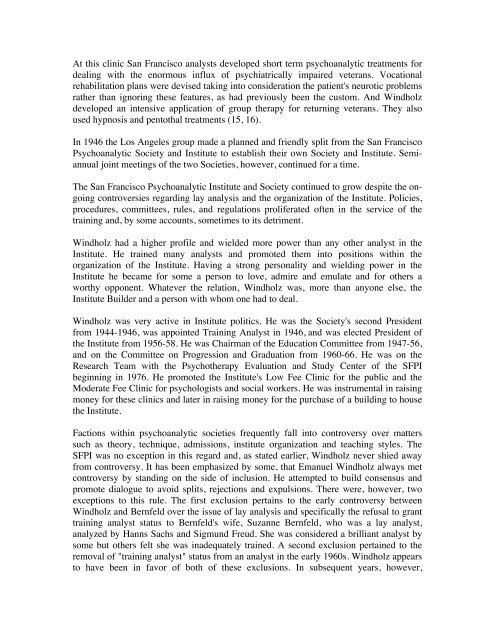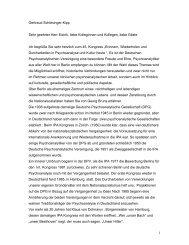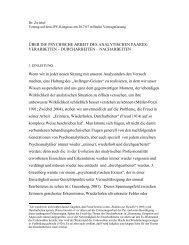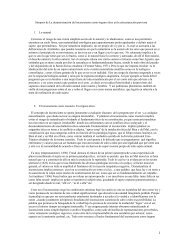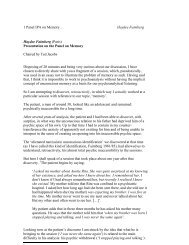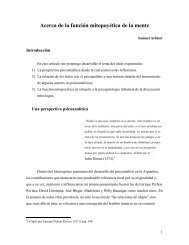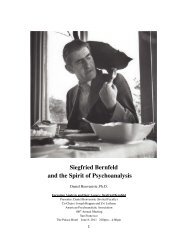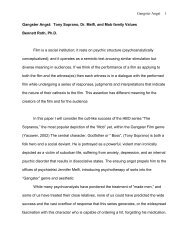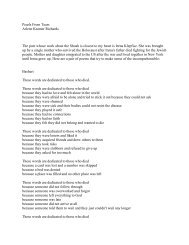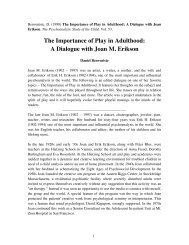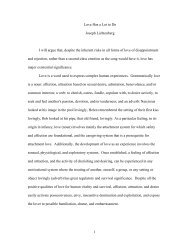Emanuel Windholz: The Institute Builder - International Psychoanalysis
Emanuel Windholz: The Institute Builder - International Psychoanalysis
Emanuel Windholz: The Institute Builder - International Psychoanalysis
You also want an ePaper? Increase the reach of your titles
YUMPU automatically turns print PDFs into web optimized ePapers that Google loves.
At this clinic San Francisco analysts developed short term psychoanalytic treatments for<br />
dealing with the enormous influx of psychiatrically impaired veterans. Vocational<br />
rehabilitation plans were devised taking into consideration the patient's neurotic problems<br />
rather than ignoring these features, as had previously been the custom. And <strong>Windholz</strong><br />
developed an intensive application of group therapy for returning veterans. <strong>The</strong>y also<br />
used hypnosis and pentothal treatments (15, 16).<br />
In 1946 the Los Angeles group made a planned and friendly split from the San Francisco<br />
Psychoanalytic Society and <strong>Institute</strong> to establish their own Society and <strong>Institute</strong>. Semiannual<br />
joint meetings of the two Societies, however, continued for a time.<br />
<strong>The</strong> San Francisco Psychoanalytic <strong>Institute</strong> and Society continued to grow despite the ongoing<br />
controversies regarding lay analysis and the organization of the <strong>Institute</strong>. Policies,<br />
procedures, committees, rules, and regulations proliferated often in the service of the<br />
training and, by some accounts, sometimes to its detriment.<br />
<strong>Windholz</strong> had a higher profile and wielded more power than any other analyst in the<br />
<strong>Institute</strong>. He trained many analysts and promoted them into positions within the<br />
organization of the <strong>Institute</strong>. Having a strong personality and wielding power in the<br />
<strong>Institute</strong> he became for some a person to love, admire and emulate and for others a<br />
worthy opponent. Whatever the relation, <strong>Windholz</strong> was, more than anyone else, the<br />
<strong>Institute</strong> <strong>Builder</strong> and a person with whom one had to deal.<br />
<strong>Windholz</strong> was very active in <strong>Institute</strong> politics. He was the Society's second President<br />
from 1944-1946, was appointed Training Analyst in 1946, and was elected President of<br />
the <strong>Institute</strong> from 1956-58. He was Chairman of the Education Committee from 1947-56,<br />
and on the Committee on Progression and Graduation from 1960-66. He was on the<br />
Research Team with the Psychotherapy Evaluation and Study Center of the SFPI<br />
beginning in 1976. He promoted the <strong>Institute</strong>'s Low Fee Clinic for the public and the<br />
Moderate Fee Clinic for psychologists and social workers. He was instrumental in raising<br />
money for these clinics and later in raising money for the purchase of a building to house<br />
the <strong>Institute</strong>.<br />
Factions within psychoanalytic societies frequently fall into controversy over matters<br />
such as theory, technique, admissions, institute organization and teaching styles. <strong>The</strong><br />
SFPI was no exception in this regard and, as stated earlier, <strong>Windholz</strong> never shied away<br />
from controversy. It has been emphasized by some, that <strong>Emanuel</strong> <strong>Windholz</strong> always met<br />
controversy by standing on the side of inclusion. He attempted to build consensus and<br />
promote dialogue to avoid splits, rejections and expulsions. <strong>The</strong>re were, however, two<br />
exceptions to this rule. <strong>The</strong> first exclusion pertains to the early controversy between<br />
<strong>Windholz</strong> and Bernfeld over the issue of lay analysis and specifically the refusal to grant<br />
training analyst status to Bernfeld's wife, Suzanne Bernfeld, who was a lay analyst,<br />
analyzed by Hanns Sachs and Sigmund Freud. She was considered a brilliant analyst by<br />
some but others felt she was inadequately trained. A second exclusion pertained to the<br />
removal of "training analyst" status from an analyst in the early 1960s. <strong>Windholz</strong> appears<br />
to have been in favor of both of these exclusions. In subsequent years, however,


